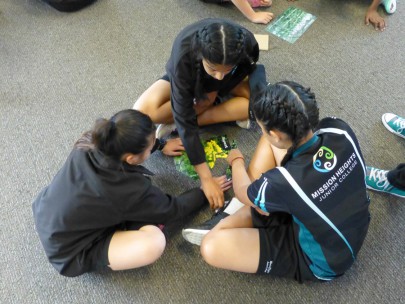Mission Heights Junior College, Auckland
In this section
-
Participating schools
- Curious Minds visit Lincoln
- Franz Josef & Fox Glacier Schools
- Greymouth High School
- Haast School
- Halswell Domain
- Halswell School
- Heathcote Valley School
- Kaniere School
- Kaniere visit Lincoln
- Hokitika Primary
- Leeston Consolidated School
- Manuka Primary School
- Mission Heights
- Mt Albert Grammar
- Paroa School
- Rudolf Steiner School
- Takapuna Grammar
- TKKM
- Wakaaranga Primary School
- Whataroa School

Students assembling weed jigsaws.
The TLC has previously taught their sustainability programme at Mission Heights, so Monique was already well known to the school. This helped for our weed education delivery on this trip.
The Mission Heights area is a relatively new subdivision, situated on a redeveloped hillside and with small sections in relation to the house sizes. There seems little scope for large vegetable gardens or extensive landscaping on these properties, so our teaching hopefully helped to reconnect the students with the natural world. The 27 Y7 students that we taught are culturally diverse, and get along with each other very well.
The first day followed our now familiar schedule of explaining what weeds are, perceptions and values of plants, and teaching about ecological relationships of plants and animals. The class then went outside to examine some weeds growing locally on the school grounds, and used the pre-loaded apps on our smartphones to record and identify them.
Our field trip on the second day was at nearby Silvana Reserve, which follows a stream with an adjacent retention pond. The reserve has a mixture of older indigenous and exotic trees and younger restoration/landscape plantings. There was also a good selection of weeds for the students to discover.
Joining us on this field day were several of the school's teachers, along with Hugh, Murray and Monique. Andrew Jenks (from Wai Care) and his colleague Jorge also joined us, and they were interested in seeing the resources and the apps that we were using. Wai Care works with communities to care for waterways and catchments.
Mission Heights Junior College selected their Y7 student Raiyan to travel to our research centre in Lincoln.
What were some of the plants that we found?
We found several mature trees of hawthorn (Crataegus monogyna), that obviously predate the residential subdivision of the area. These established hawthorns are producing weedy saplings in the reserve. Similarly, we found an oak sapling that would have come from an established tree nearby.
Both Chinese privet (Ligustrum sinense) and tree privet (Ligustrum lucidum) were common in the reserve. Growing under the shade of trees, hedge nettle (Stachys sylvatica) was also very common. A selection of other environmental weeds that we found are:
- creeping buttercup (Ranunculus repens)
- gorse (Ulex europaeus)
- inkweed (Phytolacca octandra)
- Japanese honeysuckle (Lonicera japonica)
- pampas grass (Cortaderia).
Water-loving environmental weeds growing alongside the stream included:
- arum lily (Zantedeschia 'Green Goddess')
- crack willow (Salix × fragilis)
- slender knotweed (Persicaria decipiens)
- watercress (Nasturtium officinale)
- yellow flag (Iris pseudacorus).
After their collecting and weed recording activities, we showed the students an area where local residents had dumped their gardening waste onto the reserve. Plants that were persisting from these obvious garden discards were:
We also found an exotic orchid species that was persisting. The online science community identified it for us as pink rock orchid (Dendrobium / Thelychiton kingianum).
This demonstrated first-hand how weeds can establish from indiscriminate dumping of garden waste and it was disappointing to see how one of the few green spaces in the area was being mistreated.




















